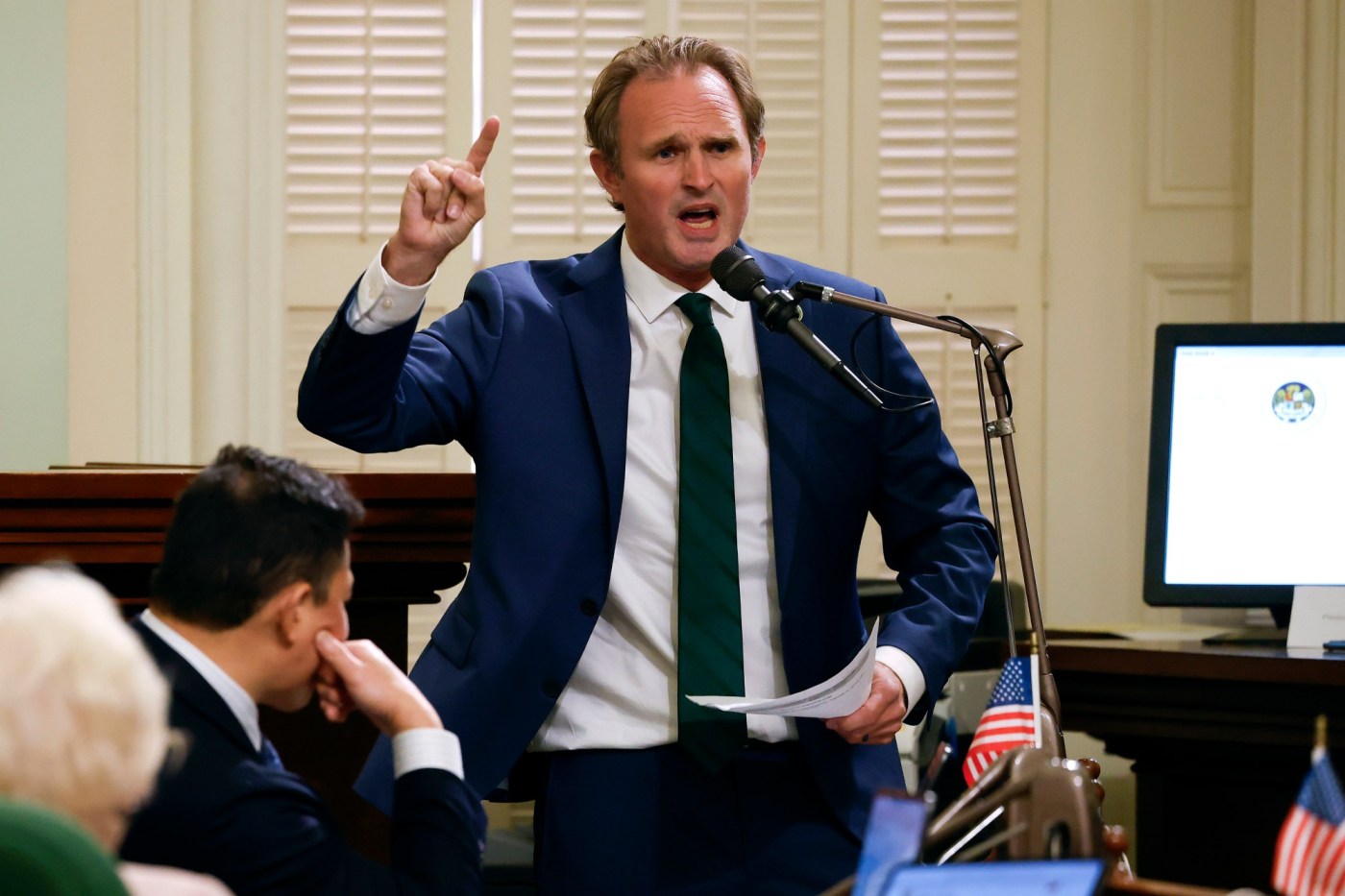
Secession.
That word has come up time and again in California politics.
And the latest person to pitch the idea is Assembly Republican Leader James Gallagher, who on Wednesday, Aug. 27, floated the idea — however unlikely — of having the Golden State’s 35 more rural or conservative inland counties break away from its generally more liberal coastal communities to form its own state.
Gallagher’s proposed map would split California in two, with the inland counties becoming the nation’s 51st state.
Assembly Minority Leader James Gallagher, R–East Nicolaus, has proposed splitting California into two states, with 35 more rural, inland counties (shown in yellow) becoming one state and more coastal counties (in blue) being another state. (Map provided by Assembly Republican Caucus)
The new state — whose name is yet to be determined — would encompass most of Northern California as well as the Sierra Nevada, Central Valley and Inland Empire, which includes San Bernardino and Riverside counties.
RELATED: California Supreme Court again rejects Republicans’ efforts to stop mid-cycle redistricting
Related Articles
California Supreme Court again rejects Republicans’ efforts to stop mid-cycle redistricting
House Republicans expand antisemitism investigation to UCSF, UCLA
Congressman Sam Liccardo unveils partnership to bolster wildfire resistance in West Valley
California Republicans mount another legal challenge to mid-cycle redistricting
What’s next for California redistricting? An expensive election
It would be made up of more than 10 million Californians, placing it among the top 10 most populous states in the nation, Gallagher said.
Although breaking off 35 of California’s 58 counties would mean that over half the state’s counties would secede, the approximately 10.5 million people who would be residents of the new state represent just a bit over a quarter of California’s current total population.
Gallagher’s so-called “two-state solution” is a long-shot proposal that comes amid California Democrats’ attempt to pass new partisan congressional maps to favor their own party ahead of the 2026 midterm elections — a response to similar gerrymandering efforts by Texas Republicans. The proposed new congressional maps, if approved by California voters in a special November election, would apply only to the 2026, 2028 and 2030 elections.
Despite Democrats’ insistence that California would revert to having an independent redistricting commission draw nonpartisan maps again following the next Census count, Gallagher said Democrats’ redistricting effort, if successful, would silence rural voices and rig the political system permanently.
“If we’re going to be talking about maps, here’s another map that maybe we should be talking about,” Gallagher said. “Because it’s very frustrating to be completely ignored, to have your people ignored time and time again.”
He said Californians who live in rural or inland places often feel that their voices and interests are dismissed by politicians in Sacramento and that their needs go unmet.
Gallagher also said he has heard from people in coastal counties who have expressed interest in joining the new state, should one be created, including those in Orange County and the Antelope Valley region of L.A. County.
The joint resolution that Gallagher introduced, calling for a 51st state, is coauthored by several other Republicans in the statehouse, including Southern California Assemblymembers Leticia Castillo, Tom Lackey and Kate Sanchez.
But the idea of a new state forming may remain just that — an idea.
For the inland counties to establish their own statehood, the idea would have to be approved by both houses of the state legislature. Congress would also have to vote for the formation of a new state.
Gov. Gavin Newsom slammed the Republican effort, calling it a “stunt that will go nowhere.”
“A person who seeks to split California does not deserve to hold office in the Golden State,” the Democratic governor said.
Nick Miller, a spokesperson for Assembly Speaker Robert Rivas’ office, also criticized the idea.
“Assembly Republicans say they oppose gerrymandering but just drew this joke of a map, a true James Gallamander,” Miller said.
Throughout California’s history, there have been at least 220 attempts or proposals to split up the state, according to the California State Library.
This included in 2011, when Riverside County Supervisor Jeff Stone, a Republican, proposed having 13 conservative or inland counties — including Orange, San Diego, Riverside and San Bernardino — form a new state.
And just three years ago, San Bernardino County asked voters if they wanted elected officials to study options for ensuring the county gets its fair share of government funding, “up to and including secession from the state.” Voters approved the idea, but when a study came back, the report showed that the county was receiving more than its fair share of state and federal funding and that seceding from California was both unnecessary and unlikely.
Gallagher said he expects the formation of a new state to be a long and involved process, but he wants to start those conversations now.
And, he insisted, what he’s proposing isn’t a stunt.
For some, the Assembly minority leader’s use of the phrase “two-state solution” brought to mind the situation in Gaza between Palestine and Israel.
During Thursday’s press conference, Gallagher also invoked the phrase “let my people go,” a command given by God to the Pharaoh in the book of Exodus. He urged the governor to support a secession plan so that, as Gallagher described it, Californians in districts like his who believe they’re not well represented in Sacramento can get a state government that they feel would work better for them.
“Gavin, let my people go,” Gallagher said. “We would like a better way forward. And we can no longer abide a government that gives us no voice.”